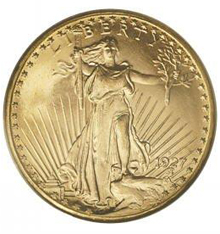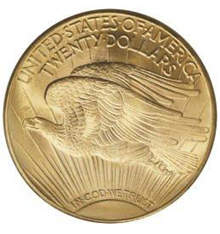 1927-D $20 MS67 PCGS. As we previously indicated in the introductory section to the 1927-D double eagle, this issue is considered to be the rarest U.S. gold coin of the 20th century, and is the rarest coin of any denomination or metal from this century. As we also wrote, fewer than 12 pieces are known in all grades, and PCGS and NGC have certified a total of ten examples, some of which may be resubmissions. Auction appearances of this issue are few--only six or seven coins having been in major sales over the past 20 years. Three specimens are in the Smithsonian National Collection.
1927-D $20 MS67 PCGS. As we previously indicated in the introductory section to the 1927-D double eagle, this issue is considered to be the rarest U.S. gold coin of the 20th century, and is the rarest coin of any denomination or metal from this century. As we also wrote, fewer than 12 pieces are known in all grades, and PCGS and NGC have certified a total of ten examples, some of which may be resubmissions. Auction appearances of this issue are few--only six or seven coins having been in major sales over the past 20 years. Three specimens are in the Smithsonian National Collection.
We present below some of the sales in which the '27-D has appeared in the recent past. Superior offered a Brilliant Uncirculated example in its February 1973 sale, which was described as frosty with minimal abrasions (lot 1041). Bowers and Ruddy, in its October 1982 Eliasberg sale, sold a Choice Brilliant Uncirculated piece (lot 1067). The Auction '84 sale included a Gem Uncirculated 65 coin offered by Paramount (lot 999), which was described as "Fully struck and lustrous with superb orange and greenish-gold toning. Identifiable by a small bagmark on the 9th ray (from left) and a faint hairline in the left obverse field by the end of Liberty's flowing hair." In October 1985, Stack's included a Choice Brilliant Uncirculated piece in its Primary Bartle Collection sale, where it was described as having "frosty luster" and being "sharply struck" with "light coppery toning" (lot 868). This same coin appeared in Superior's August  1992 sale as lot 686. The coin was readily identifiable by a comparison of photos from the two catalogs that revealed a light contact mark located on the middle of the fourth ray down beneath Liberty's left arm, and another on the ray just above the D mintmark. In our June 1995 sale, we offered an NGC-graded MS66 specimen, which we described as heavily frosted with rich, variegated orange-gold coloration (lot 6026). The Paramount example in Auction '84 reappeared as lot 115 in David Akers' Thaine Price Sale. This specimen was easily identified by a series of minute marks on and between the rays on the left (facing) obverse. A Gem Brilliant Uncirculated specimen described as "beautifully toned in a rich medium yellow shade of gold" appeared in Sotheby's/Stack's October 2001 sale of the Jeff Browning Collection (lot 206).
1992 sale as lot 686. The coin was readily identifiable by a comparison of photos from the two catalogs that revealed a light contact mark located on the middle of the fourth ray down beneath Liberty's left arm, and another on the ray just above the D mintmark. In our June 1995 sale, we offered an NGC-graded MS66 specimen, which we described as heavily frosted with rich, variegated orange-gold coloration (lot 6026). The Paramount example in Auction '84 reappeared as lot 115 in David Akers' Thaine Price Sale. This specimen was easily identified by a series of minute marks on and between the rays on the left (facing) obverse. A Gem Brilliant Uncirculated specimen described as "beautifully toned in a rich medium yellow shade of gold" appeared in Sotheby's/Stack's October 2001 sale of the Jeff Browning Collection (lot 206).
The Superb Gem '27-D we offer from the Phillip Morse Collection is the single finest known specimen certified by either PCGS or NGC (9/05). This coin radiates dazzling luster on both obverse and reverse. The bright frosty surfaces display variegated apricot and brass-gold patination over each side, and reveal no copper stains. The design elements are well impressed throughout, with the Capitol building, the olive branch, and the leaves beneath the rock exhibiting sharp definition. Some minor softness is seen on the stars along the lower obverse border, which is typical of this issue. A few miniscule, unobtrusive marks on Liberty's midsection and head and in the left (facing) obverse field are mentioned solely for accuracy, as they do not detract in the least from the fantastic overall eye appeal generated by this magnificent specimen. Indeed, were it not for these, this coin may possibly have graded even higher!
The present coin is struck from the same pair of dies as are all other known specimens. (As we pointed out in the introduction to the '27-D, Mint records indicate that four pairs of dies were prepared to coin 1927-D double eagles). While there is some speculation that the Smithsonian examples may have been struck from other dies, we are not able to confirm this. All of the known coins (including the present Morse specimen) outside of the Smithsonian collection show a thin die break through the top of L in LIBERTY, another from the bottom of the L through the I to the torch, and another thin vertical break through the eagle's beak.
Ex: Stack's (3/91), lot 1217, where it was bought by Jay Parrino for $522,500.
From The Phillip H. Morse Collection of Saint-Gaudens Coinage.(#9187)